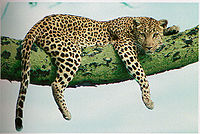Leopard
| Leopard | |
|---|---|

| |
| Scientific classification | |
| Kingdom Information | |
| Kingdom | Animalia |
| Phylum Information | |
| Phylum | Chordata |
| Class Information | |
| Class | Mammalia |
| Order Information | |
| Order | Carnivora |
| Family Information | |
| Family | Felidae |
| Genus Information | |
| Genus | Panthera |
| Species Information | |
| Species | P. pardus |
| Subspecies | P. p. pardus P. p. orientalis P. p. nimr P. p. fusca P. p. delacouri P. p. melas P. p. japonensis P. p. saxicolor P. p. kotiya |
| Population statistics | |
| Conservation status | Near-threatened |
The leopard is a large spotted feline, widely distributed throughout Africa and Asia. It is sometimes referred to as the panther, especially rare melanistic black leopards (which are also spotted, but black-on-black so that the spots are not readily apparent).
The three lions on the royal arms of England and Britain (and on the badge of the England football team) are known in heraldic terms as 'leopards'. The heraldic 'leopard' is a 'lion passant gardant'; a lion walking to the viewer's left and looking at the viewer.[1][2][3]
Contents
Habits
Leopards are solitary predators. They habitually climb trees, commonly storing their prey in a forked branch.
Leopards are prone to attacking and eating domestic dogs.
Man-eating leopards
Although man-eating leopards are much rarer than man-eating tigers, the Panar leopard claimed over 400 victims and the Man-Eating Leopard of Rudraprayag managed to eat at least 125 Indian pilgrims before it was shot by Jim Corbett.
Biblical references
Leopards historically occurred naturally in Palestine (where they are now either extinct or extremely rare) and are mentioned several times in the Bible, including,
Can the Ethiopian change his skin, or the leopard his spots? then may ye also do good, that are accustomed to do evil. Jeremiah 13:23
And the beast which I saw was like unto a leopard, and his feet were as the feet of a bear, and his mouth as the mouth of a lion: and the dragon gave him his power, and his seat, and great authority. Revelations 13:2
Leopards in popular culture
The Jungle Book by Rudyard Kipling features a major character named Bagheera, a black Indian leopard who is a mentor figure to Mowgli and is one of his friends. He is well-known as a powerful hunter, as bold as a buffalo and as reckless as an elephant as is described, and he is one of the most feared animals in the jungle just after Shere Khan the tiger. "Mowgli's Brothers" reveals that Bagheera was born in captivity in a king's palace, but after his mother died, he broke out of his cage and escaped into the wild and became a feared predator. The Disney movies - both 1967 and 2016 - have him be a sterner character yet just as devoted to Mowgli's safety and well-being.
The Warriors book series does not feature leopards, but cats regard leopards with reverence as they believe that they had inherited their hunting skills. Cats are even sometimes named after them, like Leopardfur.
See also
- The Leopard—A Historical novel by Guiseppe di Lampedusa.